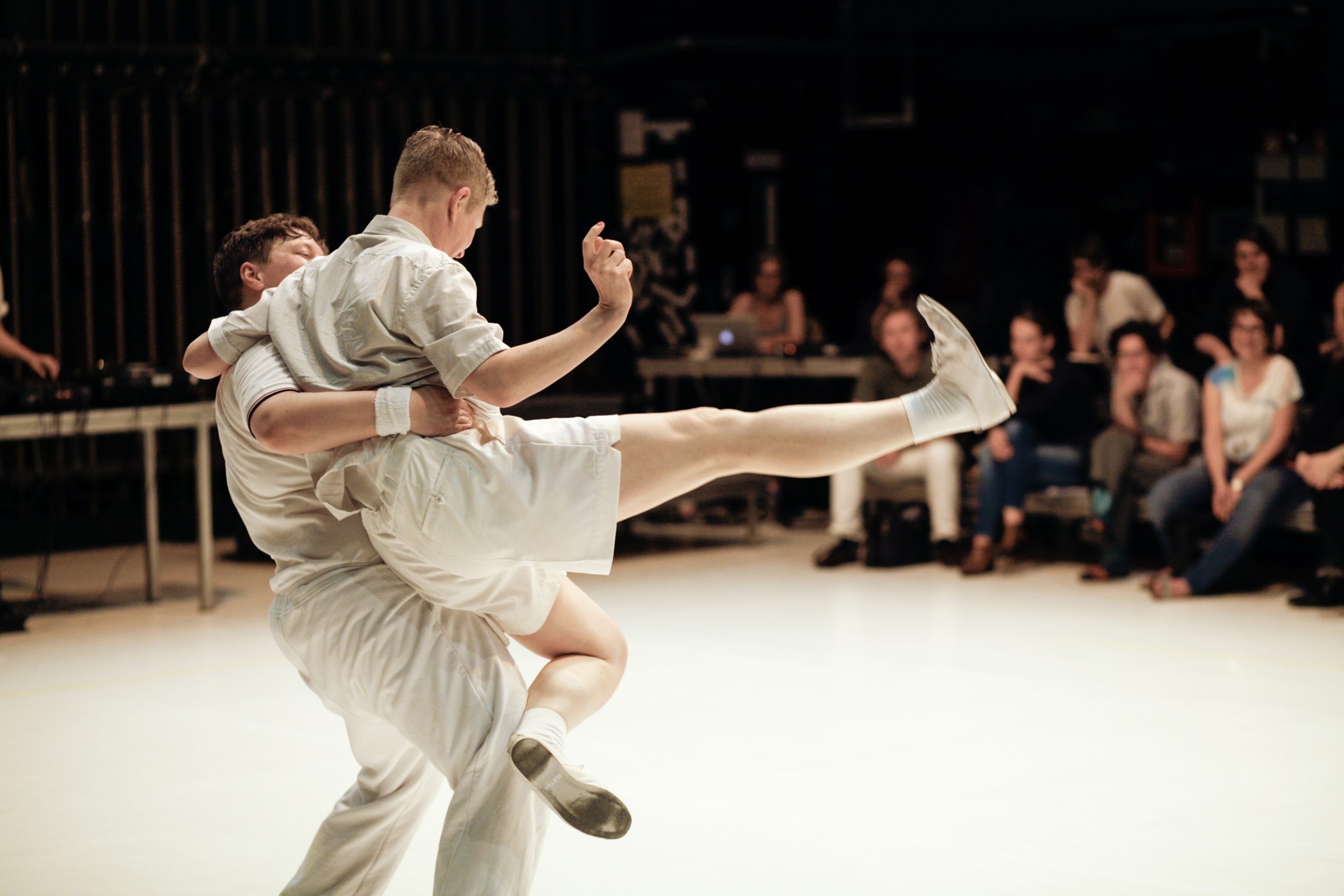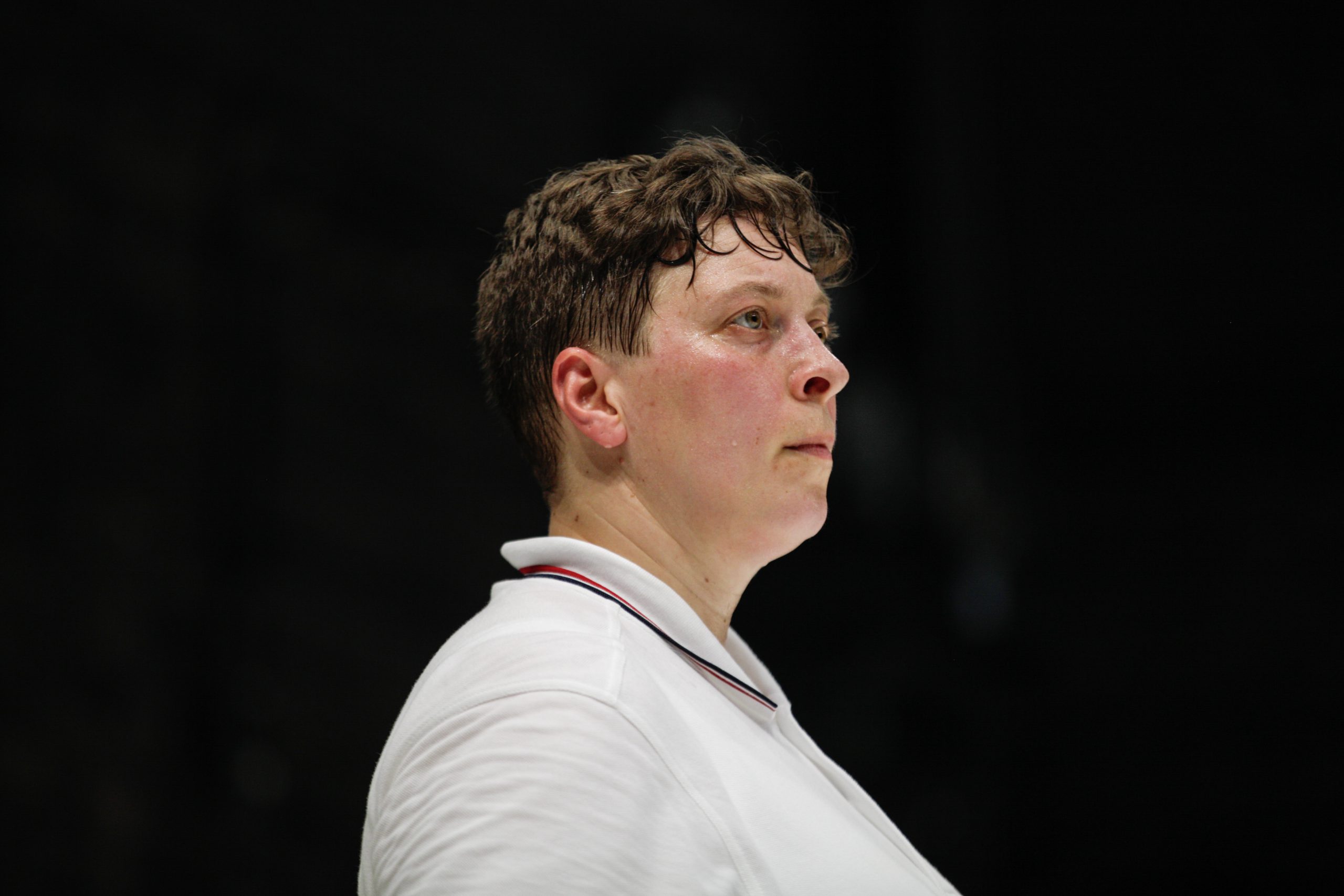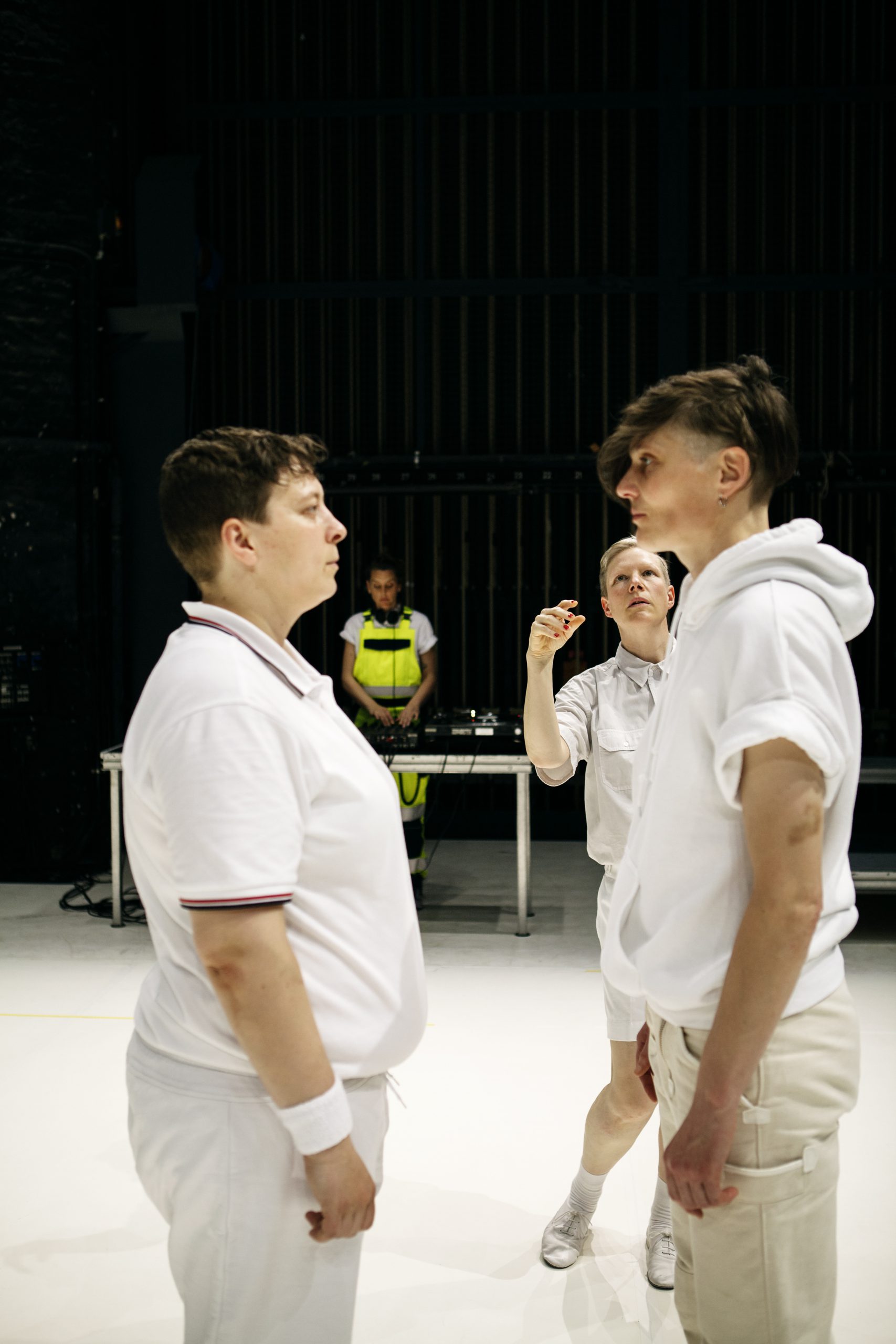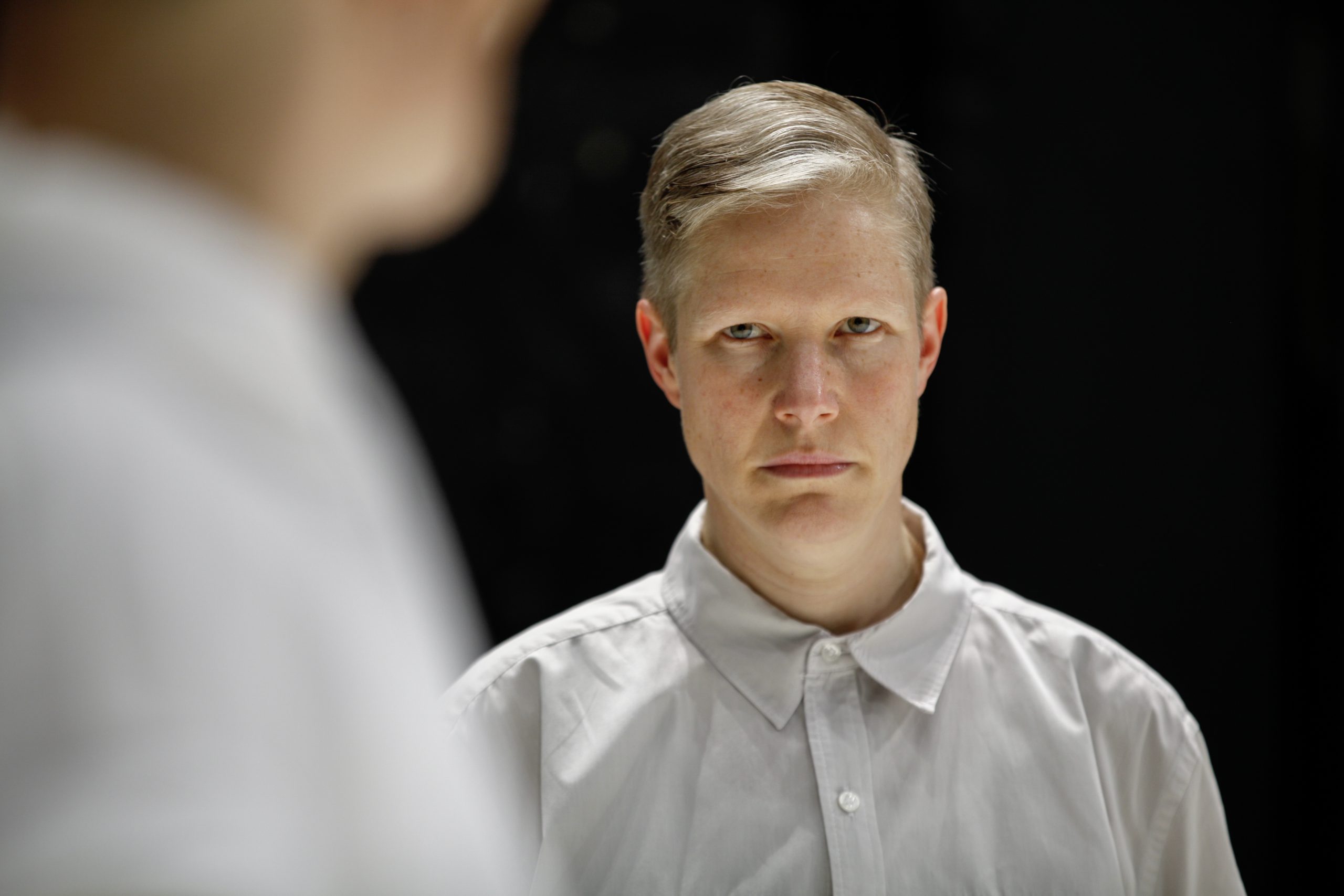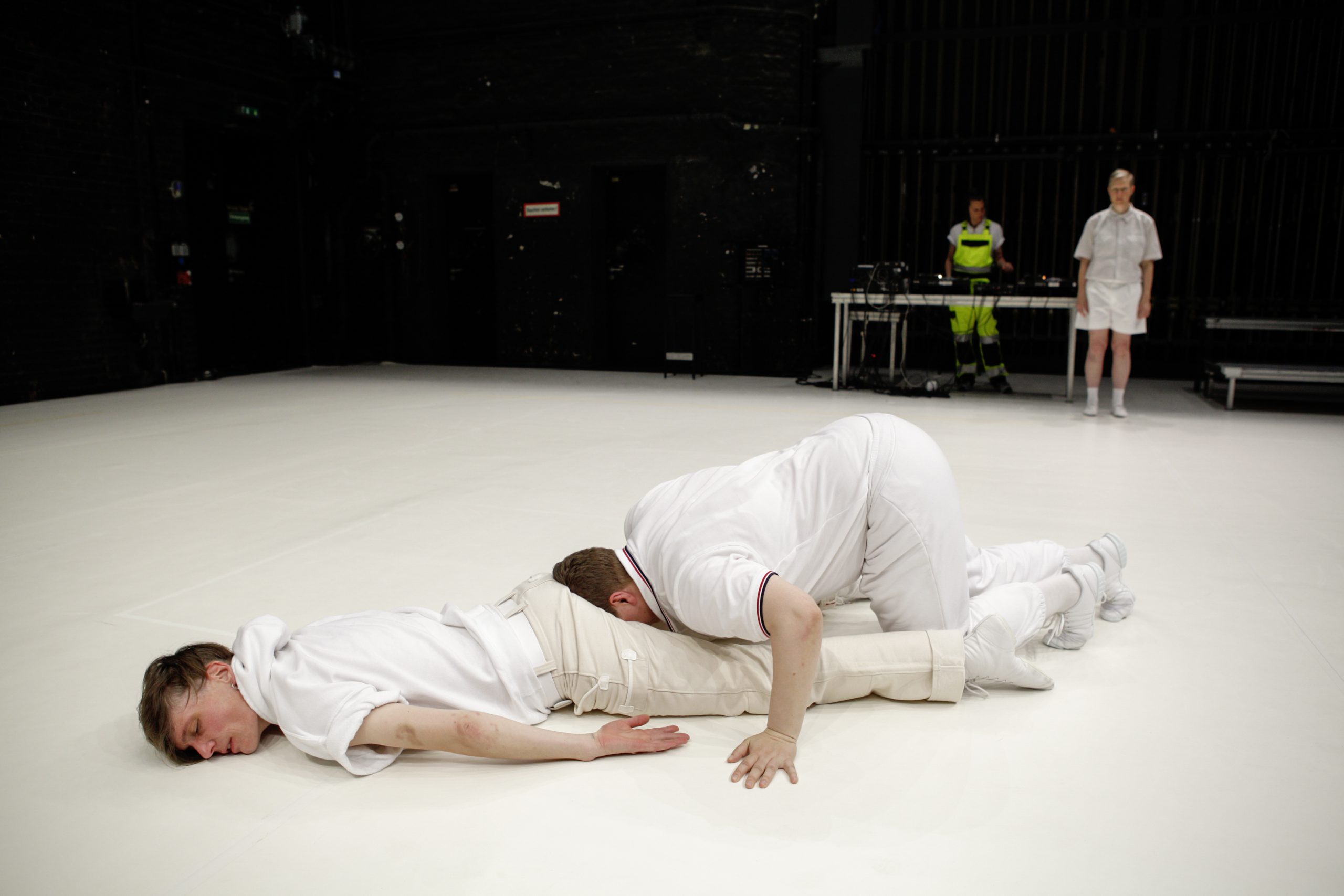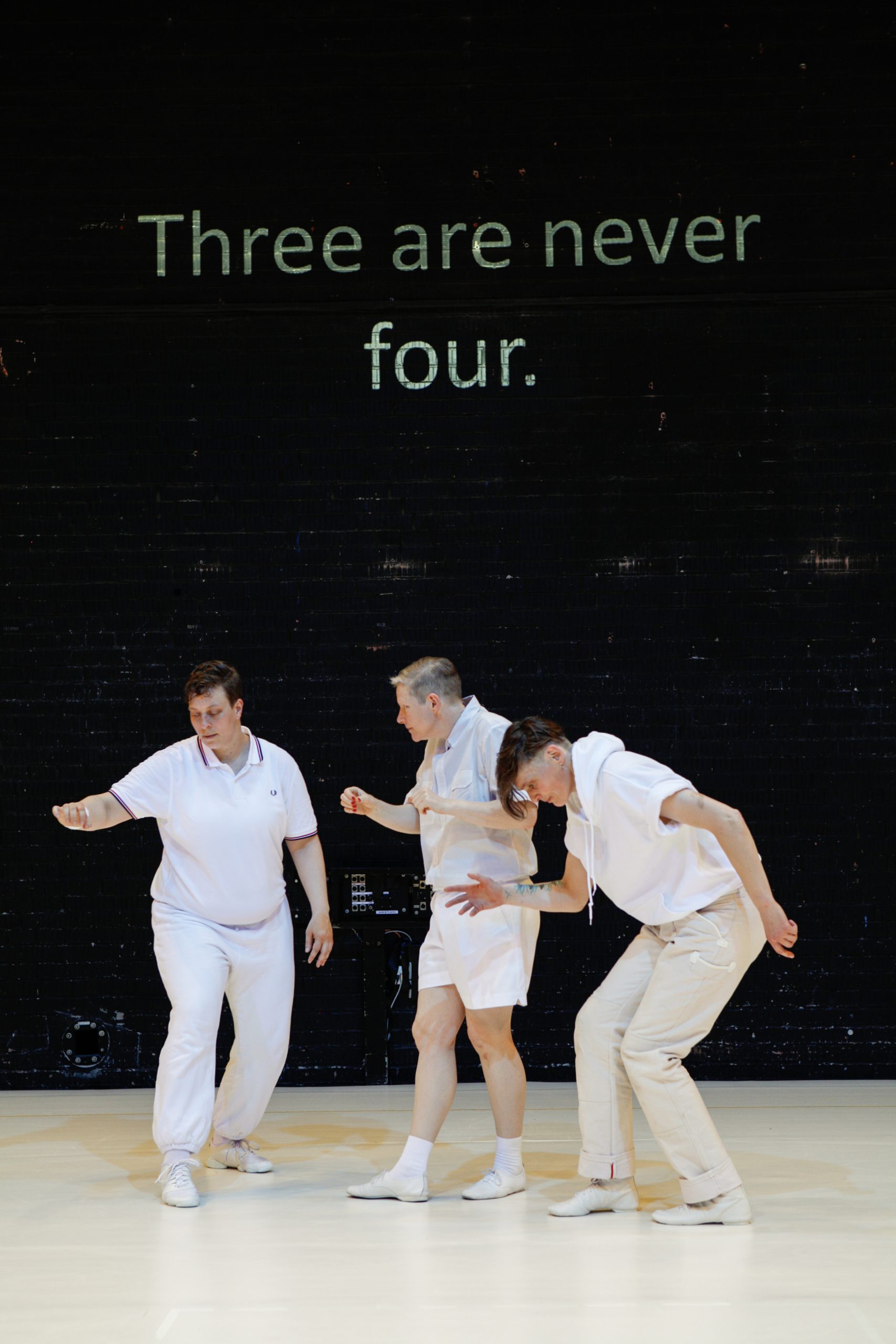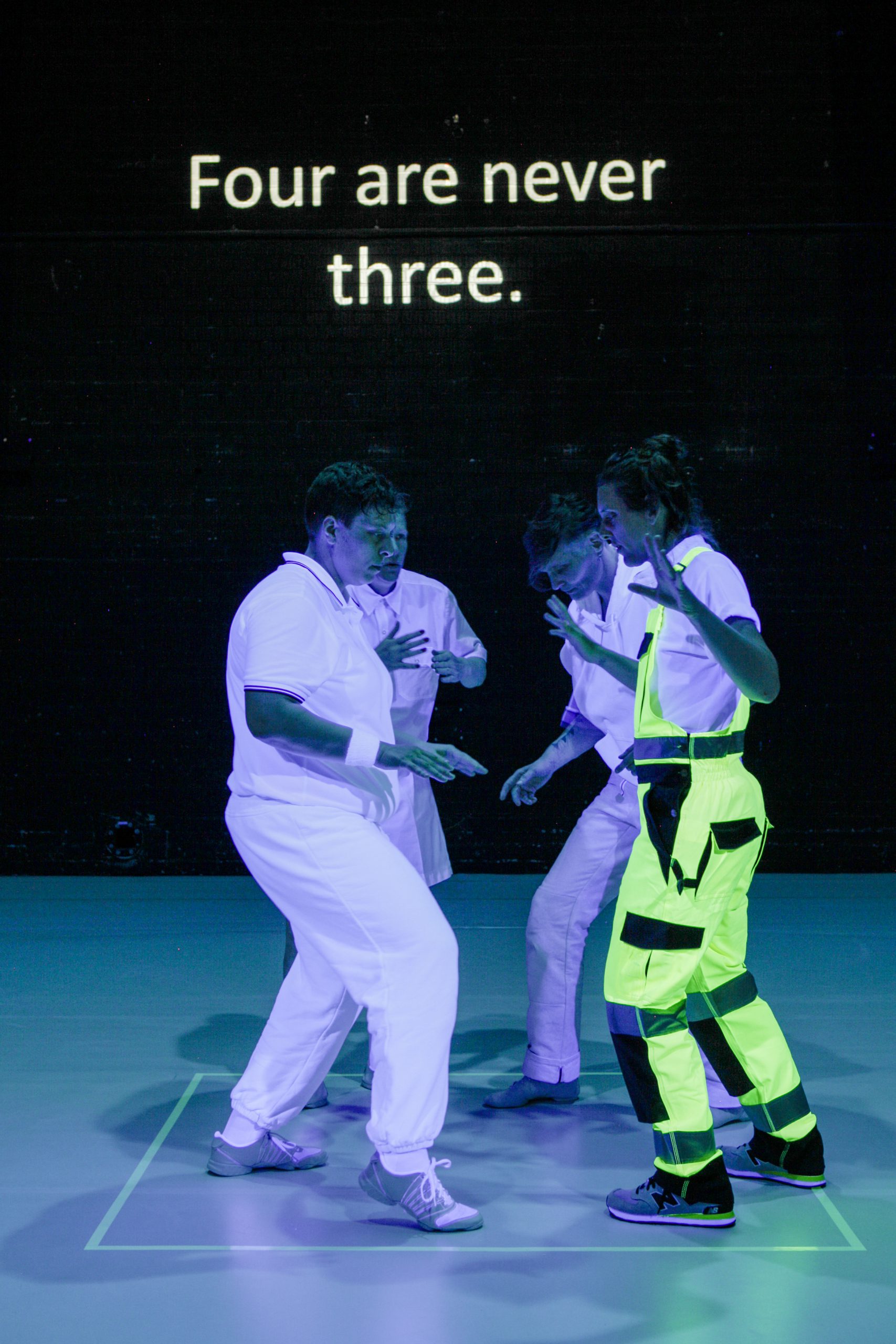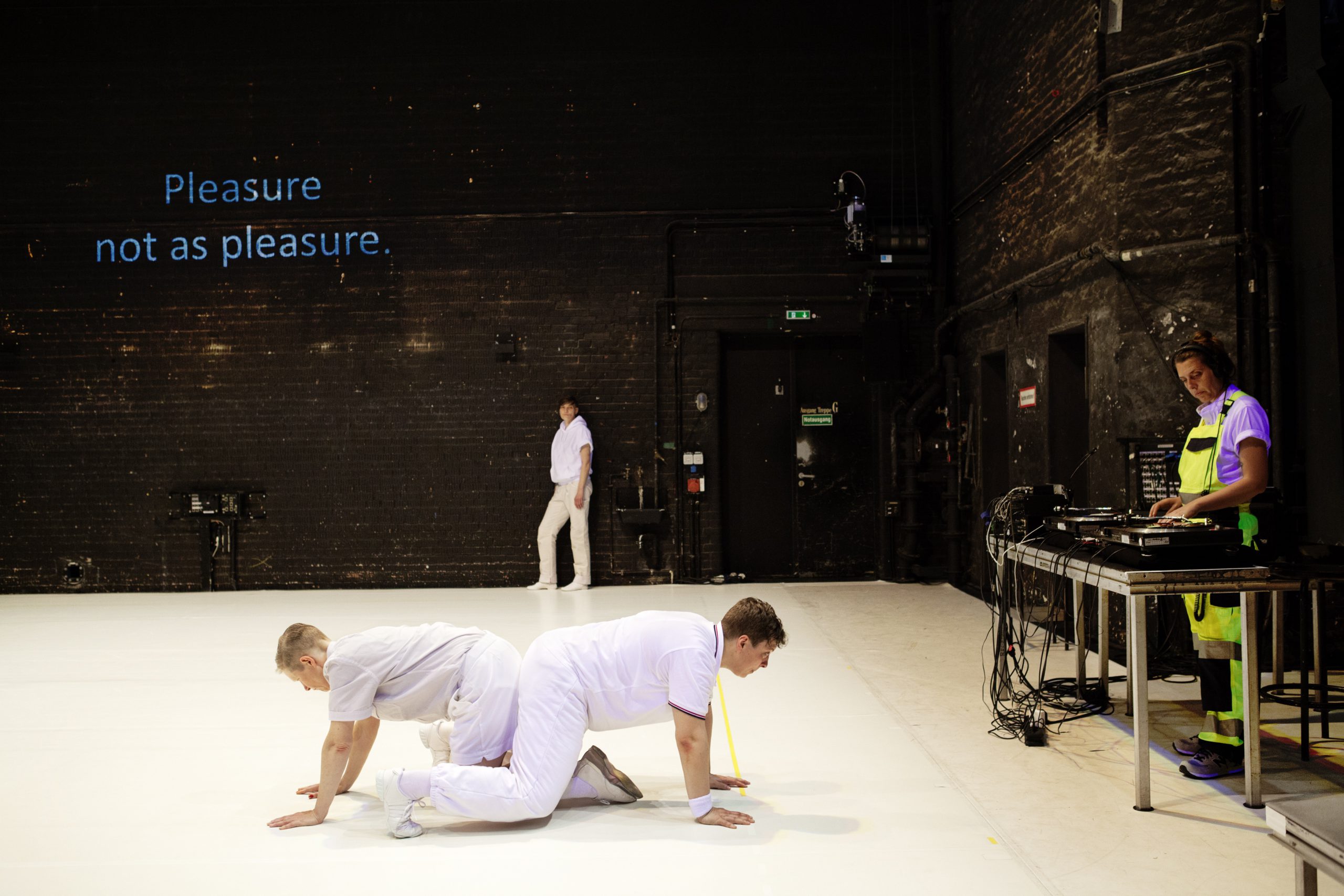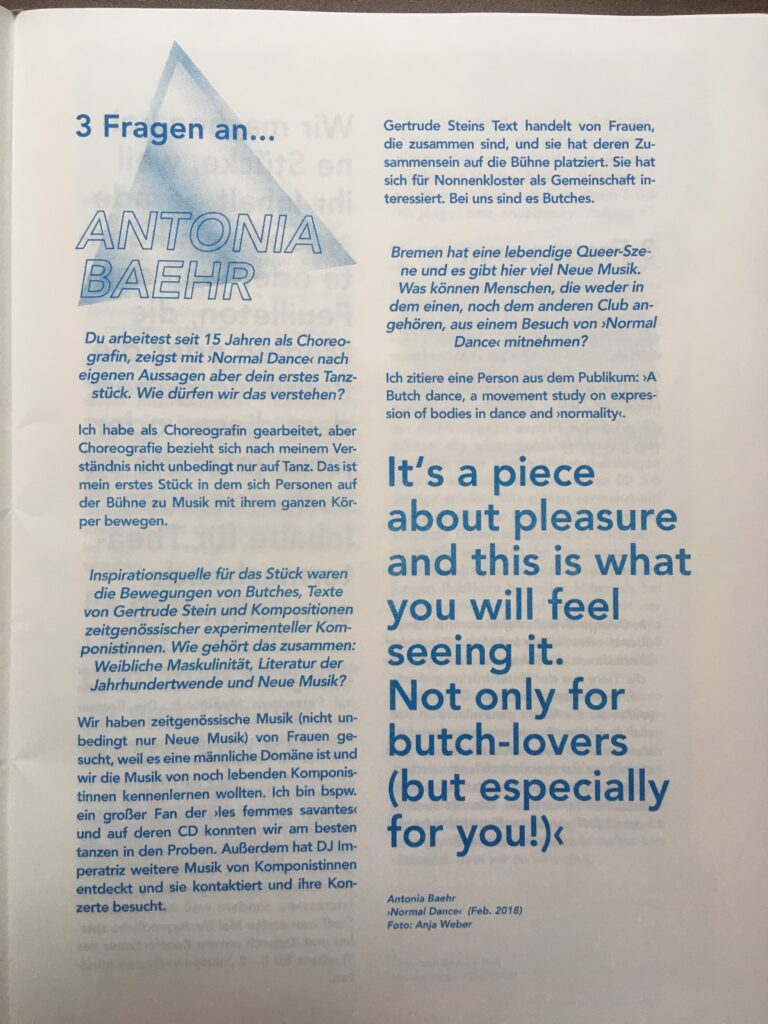engl.
Normal Dance
With Normal Dance, Antonia Baehr, who has been working as a choreographer for about fifteen years, will sign her first dance piece. ‘Normal Dance’is a dance trio that strives to integrate itself into the avant-garde of contemporary dance. She has invited two friends to dance who have much in common with her, Mirjam Junker and Pia Thilmann. Unlike Antonia Baehr, Pia Thilmann and Mirjam Junker do not habitually view contemporary stage dance, however the three of them do share the fact that their bodies are not trained for the type of activity usually required by it. The three of them are based in Berlin and share the embodiment of female masculinity: firm grips, grounded supports, strength, bigness. It’s a trio for three butches who are butches, but at the same time they are many other things. The dance is written based on the three performers’ corporality, morphology and motor functions. It is structured and framed by Gertrude Stein’s words from her opera Four Saints in Three Acts of 1927. The music is a record-collection of contemporary experimental music by female composers spun live by Djane CC Emperatriz. The audience is invited to sit around the dance, in proximity to it.
The piece consists of moving bodies. Through proximity and distance to each other, they form relation. This makes a landscape. This makes a composition of geometrical forms, in lines, in diagonals, in parallels, in crosses, in triangles. The piece may be about this if it may and if you may or even if I may like it so. So then it may be about dance as a form of being together and apart, dance as a form of community. A trio is not a light fare: one plus one, one plus two, two plus one, one plus one plus one, and seldom three harmonically all together. At the end, three strong individuals share one limited space.
“You look ridiculous if you dance. You look ridiculous if you don’t dance. So you might as well dance.” Gertrude Stein, Three Lives
de.
Normal Dance
Antonia Baehr arbeitet seit fünfzehn Jahren als Choreografin und bringt nun mit ‚Normal Dance’ ihr erstes Tanzstück auf die Bühne. ‚Normal Dance’ ist ein Tanztrio welches sich in die Avantgarde des zeitgenössischen Bühnentanzes einschreiben möchte. Hierzu lädt sie Mirjam Junker und Pia Thilman ein, zwei Freundinnen, die ihr in vielem ähnlich sind. Im Gegensatz zu Antonia Baehr schauen sich Pia Thilmann und Mirjam Junker gewöhnlicherweise keine zeitgenössischen Tanzstücke an. Allen drei ist aber gemeinsam dass ihre Körper für die vom zeitgenössischen Tanz normalerweise geforderte Form der Aktivität nicht trainiert sind. Alle drei leben in Berlin und verkörpern eine feminine Maskulinität: kräftiger Griff, fester Stand, Stärke, Kaliber. Ein Trio für Butches die auch noch viel mehr sind. Der Tanz beruht auf die Körperlichkeit, die Morphologie und die motorischen Funktionen der drei Performerinnen. Strukturiert und gerahmt werden die Tänze von Getrude Steins Sätze aus ihrer Oper Four Saints in Three Acts aus dem Jahr 1927. Die Musik besteht aus zeitgenössischen, experimentellen Kompositionen von Frauen. Als Schallplattensammlung zusammen gestellt werden diese von DJane CC Emperatriz live aufgelegt. Das Publikum ist eingeladen um den Tanz herum, in unmittelbarer Nähe dazu Platz zu nehmen.
“Du machst dich lächerlich wenn du tanzt. Du machst dich lächerlich wenn du nicht tanzt. Also kannst du genauso gut auch tanzen. “ Gertrude Stein, Three Lives
Normal Dance
Concept: Antonia Baehr
Performance: Antonia Baehr, Mirjam Junker, Pia Thilmann
Choreography: Antonia Baehr, Valérie Castan, Mirjam Junker, Pia Thilmann, Maya Weinberg
Artistic assistant: Valérie Castan,
Movement research: Maya Weinberg
Technical direction and sound design: Carola Caggiano (DJane CC Imperatriz)
Light design: Miss Candless
Light and video: Moni Hartwig
With music by: Ursula Bogner, Delya Derbishire, Sabine Ercklentz, Annette Krebs, Magda Mayas, Rie Nakayima, Andrea Neumann, Zeena Parkins, Les Femmes Savantes, Nancy Tobin, Miki Yui
Surtitles from the opera: ‚Four Saints in Three Acts‘ by Gertrude Stein (1927), Additional text from the novel: ‚Les Guérillères‘ by Monique Wittig (1969)
Production management: Xenia Leydel
Internship: Joana Tischkau
Production: Alexandra Wellensiek / make up productions
Coproduction: HAU Hebbel am Ufer (Berlin), Schwankhalle (Bremen), DeVIR/CAPa – Centro de Artes Performativas do Algarve (Residency)
Supported by: Hauptstadtkulturfonds Berlin
Thank you to: Lee Meir, Jack Smith, Pauline Boudry & Renate Lorenz, Irene Revell (electra), Ida Wilde (Keren Ida Nathan), Theaterhaus Mitte, a.o.
Premiere: 2.-5.06.2016
Duration: 50min
Tanz ist nie normal, Antonia Baehrs ‚Normal Dance‘ im Mousonturm, by Melanie Suchy in Frankfurter Allgemeine Zeitung, 14.12.2016.
de.
Er stimmt auf friedliche Weise ratlos, dieser ‚Normal Dance‘, hinterlässt einen merkwürdig schwebenden Eindruck. Wie etwas das nicht festgetackert werden kann (…).
Darum scheint es im ‚Normal Dance‘ zu gehen: um die Oberfläche, das Sichtbare, das Direkte, Klare, Helle. Mit der Luft dazwischen (…).
Das die drei kein jahrelanges Tanztraining absolviert haben, ist schnell zu erkennen. Wenn Antonia Baehr loshüpt, mal den einen, dann den anderen Arm hebt, auch die Knie, sich dreht, etwas von sich wegschiebt, dann festzuhalten scheint, sich hinlegt, aufsteht (…) verbirgt sie die Amateurin nicht. Aber sie macht auch keine lustige Show eines scheiternden Versuchs draus. Auch bei Mirjam Junker und Pia Thilmann (…).
Denn während am Bühnenrand Carola Caggiano als DJane Platten zeitgenössicher Komponistinnen auflegt (…) und ein paar kurze Zeilen aus Gertrude Steins Opernlibretto ‚Four Saints in Three Acts‘ von 1928 an der Rückwand diesem ‚Dance‘ Sprache injezieren, (…) sind die drei Akteurinnen immerzu verwandelt und nicht eindeutig oder ’normal‘ Frauen, sondern auch Männer, auch Kinder.
Oder nein das Gender-Changieren liegt im Blick der Zuschauer, die drei sind immer nur (aber was heißt nur?) sie selbst (…). Das ist Tanz im besten Sinne.
Antonia Baehr im Mousonturm, Drei in der Sonne, Antonia Baehrs unprätenziöser, trotzdem raffinierter „Normal Dance“ im Frankfurter Mousonturm,
by Sylvia Staude in Frankfurter Rundschau, 12.12.2016.
de.
Baehr setzt sich gern zwischen alle Stühle und spielt mit den Erwartungen des Publikum. Das mit Hinterlist und immer einem prägnanten Konzept(…).
Ist ein ’normaler Tanz‘ einer, der nicht von Profis ausgeführt wird? Das sind die drei nicht. Sie müssen sich mit ziemlich simplen Bewegungen begnügen, trotzdem sind diese ingeniös und oft witzig (…).
Die Dreiviertelstunde ‚Normal Dance‘ ist ganz unprätentiös trotzdem raffiniert. Baehr und ihre Mitstreiterinnen und – choreografinnen zeigen eigentlich, dass die körperlichen Vorrausetzungen nebensächlich sind, wenn man nur eine Idee hat, wie der Tanz und seine Dramaturgie beschaffen sein sollen.
Antonia Baehr (Concept, Choreography, Performance)
Antonia Baehr set out one day by foot from a house in the countryside as a young explorer, performing puppet shows in town squares for her daily bread. After studying and making things, Antonia Baehr also became Werner Hirsch the dancer and horse whisperer who made choreography and films and the producer of Werner Hirsch, the musician and choreographer Henri Fleur, the composer Henry Wilt and the husband Henry Wilde. She delighted in teaching young artists at colleges and by now her work explored the fiction of the everyday and of the theatre, among other themes, often working with other artists and other scores. Then something extraordinary happened and she was invited to The Beursschouwburg in Brussels, to present an event full of the work of Baehr’s and Hirsch’s and of all the friends who had done things with her before. It was very lovely and there was a lot of laughing like in the book “Lachen” which told you how to laugh. And when that was over and the confetti was swept away, a new book full of portraits of affinities in animal metaphors was made filled with pictures, scores and etchings, which followed the performance, “Abecedarium Bestiarium” which performed in Brazil and Japan and there was more along the way, “Larry Peacock”, “My Dog Is My Piano”, Ida, the radio plays, “For Faces”, “Merci”, “Rire / Laugh / Lachen” and that is not in any order, but it all tumbled out into the sea where she wrote “Des miss et des mystères“ with Olivier, and in the middle and near the end of that she danced Tango, fell in and out of love, celebrated her parents‘ paintings, and started making a new normal dance with her friends who are not at all dancers, but some are. – written by: Ida Wilde www.make-up-productions.net
Valérie Castan (Artistic Assistant, Choreography)
Valérie Castan was born in the south of France, named as a boy before birth. Spent one night as Olivier, then became Valérie. Grew up in the Western suburb of Paris in the sleeping workers city. Wanted to dance as a very small child. Started and stopped very quickly the ballet classes of a very strict Russian professor. Trained her body to practice sports everyday, and finally quit gymnastic tournaments because of competition and the fear of falling and death. After that, she started dancing again and danced all day with other dancers and choreographers and did many things with dance. Mostly in France. Spent more nights as Olivier as a king performer. Beautiful muscles gone with menopause. The eyes and ears learned to describe live dance shows for blind people, only in French. English, she speaks badly! Never tried to speak German! Working in Berlin for many years but still doesn’t know the city. Her favourite bars in the city are Möbel Olfe on Tuesdays, Südblock and the Commune which friends have introduced her to. She smokes English cigarettes, reads and watches movies and spends time in the countryside with her wife and son. These things are the best part. Has been devoted to Antonia’s work these last 12 years. – written by: Valérie Castan
Mirjam Junker (Performance, Choreography)
After studying the law books carefully, Mirjam Junker dropped them and arrived in Berlin in 1992, to the squats and idealism of the early days. When the summers spent building and constructing dreams with friends was over, she left for an adventure sailing the Atlantic seas as a deckhand, to Italy for olive tree climbing, through London for a season or two of queer squatting and on to Tel-Aviv and Akko for a bit of romance. When she returned to Berlin, she jumped centre-stage for a few dedicated years of avant-garde performance art with a group called Primärenergie while starting to work as a bouncer at some of the toughest clubs in town. In the meantime she completed three and a half years of boat-building studies and found a dream job in a wood workshop, sanding and whistling all day to the radio, spending weekends at the door, training Aikido seriously in between. Thirteen years married and a passionate football fan, she has become recently enamoured of Liverpool FC (a passion she shares with her brother-in-law). – written by: Ida Wilde
Pia Thilmann (Performance, Choreography)
Pia Thilmann does not normally dance, but trudges through life as a butch, in Kreuzberg or elsewhere. A drag king met Werner Hirsch, a housewife cooks jam and butchers goats. A sourdough is the pet of the household. A collector is hunting for smock aprons all over the world. A tinkerer cherishes electroluminescent wire. Kids are a good reason to climb on trees or playgrounds. Rugby league was great, but is over. Swimming as a kid was great, as long as this was possible in trunks. Aids Activism and feminism improve life. After studying philosophy, many festivals passed by, organizing them is wage employment. Mexican Wrestling is a secret passion. Whether trees or succulents are the better plant friends, has yet to be discovered. – written by: Pia Thilmann
Carola Caggiano (Technical Direction, Sound Design, DJane CC Imperatriz)
Carola Caggiano grew up in a very little town on top of a beautiful mountain. In this royal place the biggest castle had 2,673 windows. Franco´s corpse is lying there under a 150m high cross. The place was scary, so she moved in 1997 to London, squatted houses and learned some circus tricks and performed on the streets. In 1999 she went back to Madrid to study Geology (still squatting!). She spent many hours and days learning rock cartography, painting colourful maps while sitting on a peak (watching the view!). In 2004 she moved to Berlin and changed her life again. It´s never too late and she started playing cello and piano with Russian teachers, studying audio waves and working in theater as a sound and light technician. During the last eight years, she has been a very passionate Taiji Quan practitioner. – written by: Carola Caggiano
Miss Candless (Light Design)
Miss Candless is based in Paris. Began on stage as a mime artist. She then left the physical theatre company she had been running for the past five years to devote herself exclusively to designing lighting. She first became interested in lighting design after taking a research workshop with the stage designer Josef Svoboda in 1990 – an encounter that was to prove decisive for her. Each project, in collaboration with choreographers, directors, visual artists, stage designers, musicians and video-makers, is an opportunity for her to continue research into creating other spatio-temporal perceptions with light or films of light video projected, in relationship to bodies. Bodies are „central“ in her way of lighting the space. She likes to swim, rebuild old houses and spend time in the countryside with her wife and friends, working in the garden and listening to birds in spring. Normal Dance is her 4th collaboration with Antonia Baehr. – written by: Ida Wilde
Maya Weinberg (Movement Research, Choreography)
Maya Weinberg grew up in one of the hottest deserts in the world gazing out at the red spring blossoms that covered the ground like a beautiful wool blanket. As a child she learned to dance and then became a principal dancer in a very principal dance company in Israel, where she danced for eight years while studying literature, feminism and philosophy. She loves teaching dance and has met many students and friends in dance and performance art festivals around the world, with whom she sometimes collaborates. She is an artist interested in the tragi-comic gap that exists between language and unexpressed intentions. Over time she became enthralled with the queer activists in Tel-Aviv and started getting to know them and doing performance and demonstrations with them. In those years the left scene in the city was blossoming like the red flowers in the desert, but she wanted to learn more and decided to pack her books, hats and sneakers and then unpack them in Berlin, where she has been dancing with many new artists. She likes to observe things, write, hear music and learn to play the flute. Adventures of the heart both big and small are the most exciting things. – written by: Ida Wilde
3 Fragen an… Antonia Baehr
de.
Du arbeitest seit 15 Jahren als Choreografin, zeigst mit ‚Normal Dance‘ nach eigenen Aussagen aber dein erstes Tanzstück. Wie dürfen wir das verstehen?
Butch Abstraction, Bettina Knaup
de.
Weiß, quadratisch, lichtdurchflutet die Bühne. Streng komponiert und lustvoll verspielt der Tanz. Drei Performerinnen in unterschiedlichen Anordnungen, miteinander, gegeneinander, nebeneinander, ineinander, allein, zu zweit, zu dritt. Und viele andere drumherum – Gertrude Stein, Djane CC Imperatriz mit weiteren Musikerinnen, das Publikum. Ein komponierter Körper aus vielen Teilen, verbunden durch spielerisches Begehren.
Normal Dance, Antke Engel
de. & engl.
Dreisamkeit. Eine Konstellation, die in den seltensten Fällen durch Stillstand gekennzeichnet ist. In Kontexten, in denen das Paar organisierendes Pinzip ist, sorgt die Drei für Unruhe – ist aber auch treibende Kraft des erotischen Austausches. Eine wiederkehrende Frage im „Normal Dance“: Welche erringt den Platz in der Sonne? Ein temporärer Genuss.
Normal Dance, by Kristina Marlen
engl.
Kristina Marlen, about Normal Dance, Berlin, 4th of June 2016.
Normal Dance, by Xavier Le Roy
engl.
Xavier Le Roy about Normal Dance, Berlin, 6th of June 2016.




